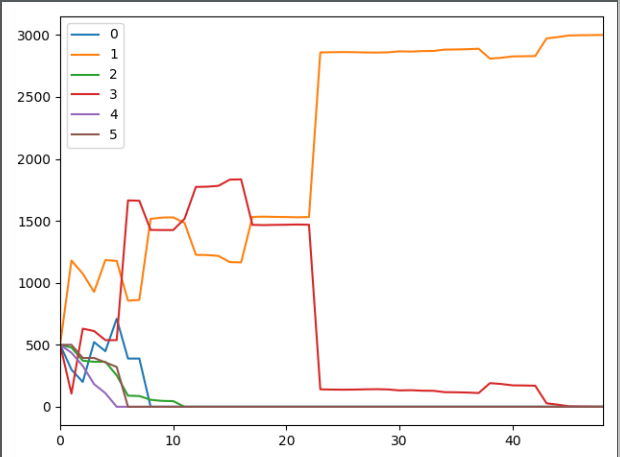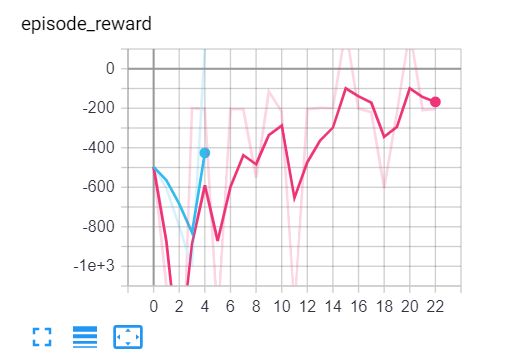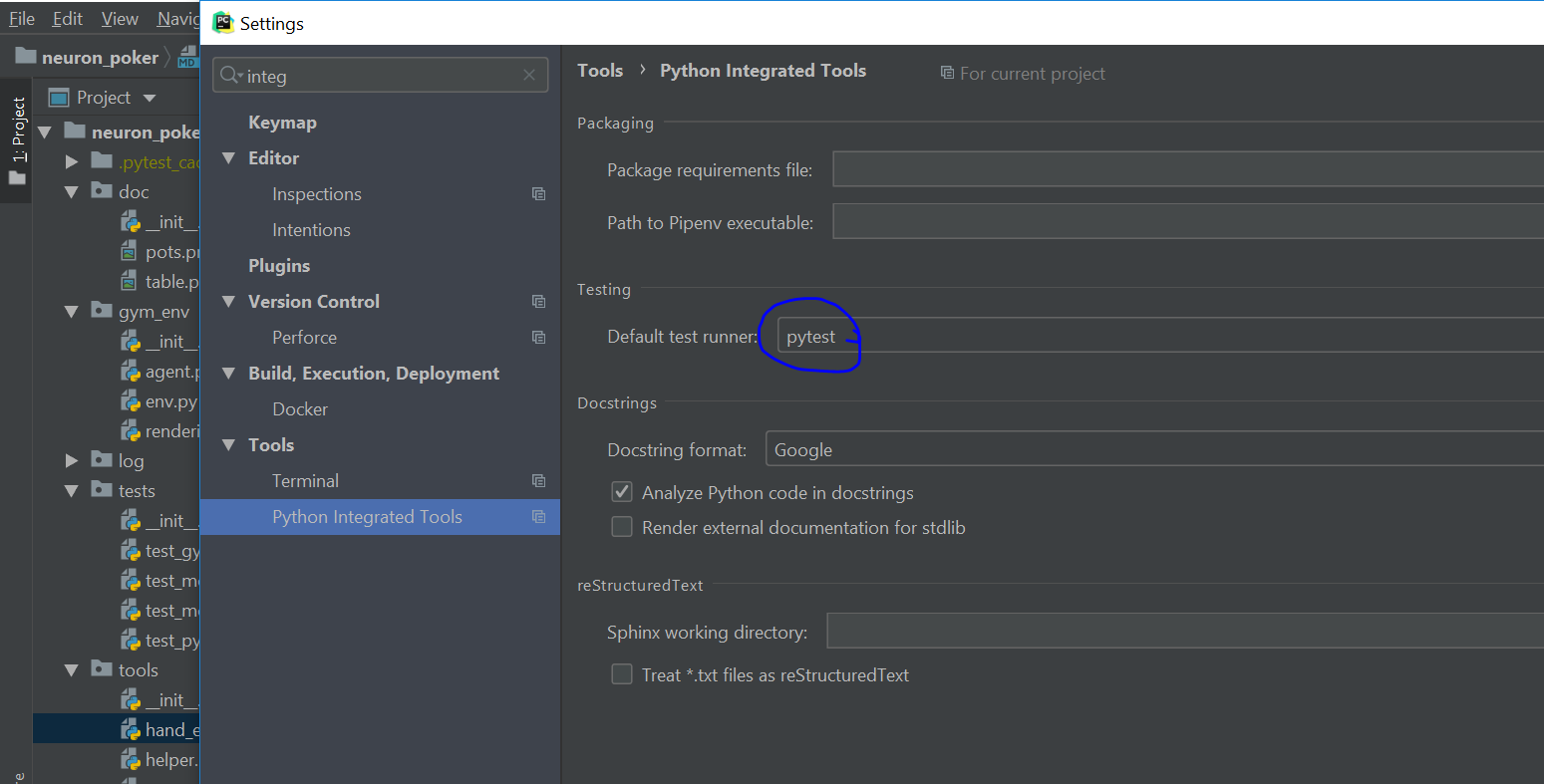This is an environment for training neural networks to play texas holdem. Please try to model your own players and create a pull request so we can collaborate and create the best possible player.
Run:
- Install Anaconda, I would also recommend to install pycharm.
pip install -r requirements.txt- Run 6 random players playing against each other:
main.py random --renderor - To manually control the players:
main.py keypress --render - Example of genetic algorighm with self improvement:
main.py equity_improvement --improvement_rounds=20 --episodes=10
At the end of an episode, the performance of the players can be observed via the summary plot.

main.py: entry point and command line interpreter. Runs agents with the gym.
env.py: Texas Hold’em unlimited openai gym environment &rendering.py: rendering graphics while playing
Please add your model based agents here.
agent_random.py: an agent making random decisionsagent_keypress.py: an agent taking decision via keypressagent_consider_equity.py: an agent considering equity information
Note that the observation property is a dictionary that contains all the information about the players and table that can be used to make a decision.
hand_evaluator.py: evaluate the best hand of multiple playershelper.py: helper functionsmontecarlo_numpy2.py: fast numpy based montecarlo simulation to calculate equity. Not yet working correctly. Some tests are failing. Feel free to fix them.montecarlo_python.py: relatively slow python based montecarlo for equity calculation. Supports preflight ranges for other players.
test_gym_env.py: tests for the end.test_montecarlo.py: tests for the hands evaluator and python based equity calculator.test_montecarlo_numpy.py: tests for the numpy montecarlotest_pylint.py: pylint and pydoc tests to ensure pep8 standards and static code analysis
- [x] Agent based on user interaction (keypress)
- [x] Random agent
- [x] Equity based strategy (i.e. call and bet above threshold)
- [x] Equity based strategy with genetic algorithm, adjusting the treshold based on winning agent.
- [x] Reinforcement learning with experience replay (Deep Q learning)
- [ ] Deep SARSA [[10]](http://people.inf.elte.hu/lorincz/Files/RL_2006/SuttonBook.pdf)
- [ ] Asynchronous Advantage Actor-Critic (A3C) [[5]](http://arxiv.org/abs/1602.01783)
- [ ] Monte Carlo counterfactual regret minimization (MCCFR) [[7]](https://science.sciencemag.org/content/early/2019/07/10/science.aay2400)
neuron_poker.agents.agent_dqn implements a deep q agent with help of keras-rl.
A number of parameters can be se:
- nb_max_start_steps = 20 # maximum of random actions at the beginning
- nb_steps_warmup = 75 # before training starts, should be higher than start steps
- nb_steps = 10000 # total number of steps
- memory_limit = int(nb_steps / 3) # limiting the memory of experience replay
- batch_size = 500 # number of items sampled from memory to train
Training can be observed via tensorboard (run tensorboard --logdir=./Graph from command line)

In main.py an agent is launched as follows (here adding 6 random
agents to the table). To edit what is accepted to main.py via command
line, simply add another line in the docstring at the top of main.py.
def random_action(render):
"""Create an environment with 6 random players"""
env_name = 'neuron_poker-v0'
stack = 500
self.env = gym.make(env_name, num_of_players=6, initial_stacks=stack)
for _ in range(num_of_plrs):
player = RandomPlayer(500)
self.env.add_player(player)
self.env.reset()As you can see, as a first step, the environment needs to be created. As a second step, different agents need to be added to the table. As a third step the game is kicked off with a reset. Agents with autoplay set to True will automatically play, by having the action method called of their class. Alternatively you can use the PlayerShell class and the environment will require you call call the step function manually and loop over it. This may be helpful when using other packages which are designed to interface with the gym, such as keras-rl.
An example agent can be seen in random_agent.py
To build a new agent, an agent needs to be created, where the follwing function is modified. You will need to use the observation parameter, which contains the current state of the table, the players and and the agent itself, as a parameter to determine the best action.
def action(self, action_space, observation): # pylint: disable=no-self-use
"""Mandatory method that calculates the move based on the observation array and the action space."""
_ = observation # not using the observation for random decision
this_player_action_space = {Action.FOLD, Action.CHECK, Action.CALL, Action.RAISE_POT, Action.RAISE_HAlF_POT}
possible_moves = this_player_action_space.intersection(set(action_space))
action = random.choice(list(possible_moves))
return actionThe state is represented as a numpy array that contains the following information:
class CommunityData:
def __init__(self, num_players):
self.current_player_position = [False] * num_players # ix[0] = dealer
self.stage = [False] * 4 # one hot: preflop, flop, turn, river
self.community_pot: float: the full pot of this hand
self.current_round_pot: float: the pot of funds added in this round
self.active_players = [False] * num_players # one hot encoded, 0 = dealer
self.big_blind
self.small_blind
class StageData: # as a list, 8 times:
"""Preflop, flop, turn and river, 2 rounds each"""
def __init__(self, num_players):
self.calls = [False] * num_players # ix[0] = dealer
self.raises = [False] * num_players # ix[0] = dealer
self.min_call_at_action = [0] * num_players # ix[0] = dealer
self.contribution = [0] * num_players # ix[0] = dealer
self.stack_at_action = [0] * num_players # ix[0] = dealer
self.community_pot_at_action = [0] * num_players # ix[0] = dealer
class PlayerData:
"Player specific information"
def __init__(self):
self.position: one hot encoded, 0=dealer
self.equity_to_river: montecarlo
self.equity_to_river_2plr: montecarlo
self.equity_to_river_3plr: montecarlo
self.stack: current player stackIt will be hard for one person alone to beat the world at poker. That's why this repo aims to have a collaborative environment, where models can be added and evaluated.
To contribute do the following:
- Get Pycharm and build the virtual python environment. Use can do:
pip install -r requirements.txt - Clone your fork to your local machine. You can do this directly from pycharm: VCS --> check out from version control --> git
- Add as remote the original repository where you created the fork from and call it upstream (the connection to your fork should be called origin). This can be done with vcs --> git --> remotes
- Create a new branch: click on master at the bottom right, and then click on 'new branch'
- Make your edits.
- Ensure all tests pass. Under file --> settings --> python integrated tools switch to pytest (see screenshot).
 You can then just right click on the tests folder and run all tests. All tests need to pass. Make sure to add your own tests by simply naming the funtion test_...
You can then just right click on the tests folder and run all tests. All tests need to pass. Make sure to add your own tests by simply naming the funtion test_... - Make sure all the tests are passing. Best run pytest as described above (in pycharm just right click on the tests folder and run it). If a test fails, you can debug the test, by right clicking on it and put breakpoints, or even open a console at the breakpoint: https://stackoverflow.com/questions/19329601/interactive-shell-debugging-with-pycharm
- Commit your changes (CTRL+K}
- Push your changes to your origin (your fork) (CTRL+SHIFT+K)
- To bring your branch up to date with upstream master, if it has moved on: rebase onto upstream master: click on your branch name at the bottom right of pycharm, then click on upstream/master, then rebase onto. You may need to resolve soe conflicts. Once this is done, make sure to always force-push (ctrl+shift+k), (not just push). This can be done by selecting the dropdown next to push and choose force-push (important: don't push and merge a rebased branch with your remote)
- Create a pull request on your github.com to merge your branch with the upstream master.
- When your pull request is approved, it will be merged into the upstream/master.
